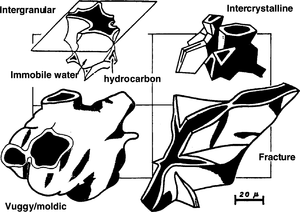Difference between revisions of "Pore system fundamentals"
Cwhitehurst (talk | contribs) |
Cwhitehurst (talk | contribs) m (added Category:Treatise Handbook 3 using HotCat) |
||
| (2 intermediate revisions by the same user not shown) | |||
| Line 1: | Line 1: | ||
| + | {{merge|Pore systems}} | ||
| + | |||
{{publication | {{publication | ||
| image = exploring-for-oil-and-gas-traps.png | | image = exploring-for-oil-and-gas-traps.png | ||
| Line 6: | Line 8: | ||
| part = Predicting the occurrence of oil and gas traps | | part = Predicting the occurrence of oil and gas traps | ||
| chapter = Predicting reservoir system quality and performance | | chapter = Predicting reservoir system quality and performance | ||
| − | | frompg = 9- | + | | frompg = 9-18 |
| − | | topg = 9- | + | | topg = 9-17 |
| author = Dan J. Hartmann, Edward A. Beaumont | | author = Dan J. Hartmann, Edward A. Beaumont | ||
| link = http://archives.datapages.com/data/specpubs/beaumont/ch09/ch09.htm | | link = http://archives.datapages.com/data/specpubs/beaumont/ch09/ch09.htm | ||
| Line 16: | Line 18: | ||
[[Porosity]] consists of relatively large voids, or pores, distributed among smaller passages called pore throats. A pore system is an aggregate of pores and pore throats that shares a similar morphology. These elements play a role in determining [[reservoir]] and [[seal]] petrophysics (the characteristic way that oil, gas, and water move through rocks). [[:file:predicting-reservoir-system-quality-and-performance_fig9-9.png|Figure 1]] shows typical 3-D pore system geometries found in intergranular, intercrystalline, vuggy, or fractured rocks. | [[Porosity]] consists of relatively large voids, or pores, distributed among smaller passages called pore throats. A pore system is an aggregate of pores and pore throats that shares a similar morphology. These elements play a role in determining [[reservoir]] and [[seal]] petrophysics (the characteristic way that oil, gas, and water move through rocks). [[:file:predicting-reservoir-system-quality-and-performance_fig9-9.png|Figure 1]] shows typical 3-D pore system geometries found in intergranular, intercrystalline, vuggy, or fractured rocks. | ||
| − | [[file:predicting-reservoir-system-quality-and-performance_fig9-9.png | + | [[file:predicting-reservoir-system-quality-and-performance_fig9-9.png|300px|thumb|{{figure number|1}}Typical 3-D pore system geometries found in intergranular, intercrystalline, vuggy, or fractured rocks. Copyright: Coalson et al.;<ref>Coalson, E. B., S. M. Goolsby, and M. H. Franklin, 1994, Subtle seals and fluid-flow barriers in carbonate rocks, in J.C. Dolson, M.L. Hendricks, and W.A. Wescott, eds., Unconformity Related Hydrocarbons in Sedimentary Sequences: RMAG Guidebook for Petroleum Exploration and Exploitation in Clastic and Carbonate Sediments, p. 45–58.</ref> courtesy RMAG.]] |
| − | |||
==Critical elements of pore-system geometry== | ==Critical elements of pore-system geometry== | ||
| Line 44: | Line 45: | ||
[[Category:Predicting the occurrence of oil and gas traps]] | [[Category:Predicting the occurrence of oil and gas traps]] | ||
[[Category:Predicting reservoir system quality and performance]] | [[Category:Predicting reservoir system quality and performance]] | ||
| + | [[Category:Treatise Handbook 3]] | ||
Latest revision as of 13:52, 4 April 2022
| It has been suggested that this article be merged with [[::Pore systems|Pore systems]]. (Discuss) |
Porosity consists of relatively large voids, or pores, distributed among smaller passages called pore throats. A pore system is an aggregate of pores and pore throats that shares a similar morphology. These elements play a role in determining reservoir and seal petrophysics (the characteristic way that oil, gas, and water move through rocks). Figure 1 shows typical 3-D pore system geometries found in intergranular, intercrystalline, vuggy, or fractured rocks.

Critical elements of pore-system geometry
The pores of a rock occur between grains or crystals, in fractures, or in vugs. A rock's storage capacity is controlled by the size and number of pores. A rock's permeability (flow capacity) is controlled by the size, shape, and number of the pore throats (connections) per pore. Four critical elements of the geometry of a rock's pore system are
- Pore system shapes
- Pore and pore throat sizes
- Pore connectivity
- Ratio of pore throats to pores
See also
References
- ↑ Coalson, E. B., S. M. Goolsby, and M. H. Franklin, 1994, Subtle seals and fluid-flow barriers in carbonate rocks, in J.C. Dolson, M.L. Hendricks, and W.A. Wescott, eds., Unconformity Related Hydrocarbons in Sedimentary Sequences: RMAG Guidebook for Petroleum Exploration and Exploitation in Clastic and Carbonate Sediments, p. 45–58.